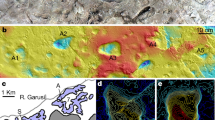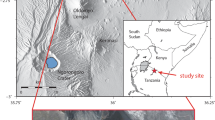Abstract
Three Hipparion trails, two from adults and one from a juvenile dating from about 3.5 Myr ago, have now been found in Laetoli. Comparison of the Hipparion footprints with a variety of imprints made by domestic horses showed that the animals moved with a running walk over the soft and slippery soil of Laetoli: in the alternative hind–fore–hind–fore footfall sequence one foot is always close to the ground and can take over the body weight if the supporting foot slides. The smaller juvenile was taking relatively longer strides than the adult. Body support was provided mainly by the third main toe. The evidence indicates that volcanic ash was falling at the time the footprints were made, suggesting that the animals were passing through the area at about the same time. The criss-cross pattern in the trails of the juvenile and adult Hipparion can be seen in the travelling behaviour of mares and foals of living horses. Evidence that the Hipparion were moving with a running walk supports the view that this gait is not ‘man-taught’ for rider-comfort, but a natural ability in modern horses.
Similar content being viewed by others
References
Alexander, R. M. Nature 261, 129–130 (1976).
Webb, S. D. Forma Functio 5, 99–112 (1972).
Leakey, M. D. & Hay, R. L. Nature 278, 317–323 (1979).
Leakey, M. D. & Harris, J. M. (eds) The Pliocene Site of Laetoli (Los Angeles, in the press).
Gromova, V. thesis, Univ. Paris (1952).
Gromova, V. Ann. cent. d'études docum. paléont. 15 (1955).
Osborn, H. F. The Age of Mammals in Europe, Asia and North America (Macmillan, New York, 1921).
Gabunija, L. K. Histoire du genre Hipparion (Acad. Sci. USSR, Moscow, transl., Bur. Rech. Min. Geol., Paris, 1961).
Tobien, H. Aus der Heimat 67, 4, 121–132 (1959).
Simpson, G. G. Horses (Oxford University Press, 1950).
Hoyt, D. F. & Taylor, R. C. Nature 292, 239–240 (1981).
Hildebrand, M. Neural Control of Locomotion (eds Herman, R. M. et al.) (Plenum, New York, 1976).
Arnason, P. Island Landbun. J. agric. Res. 11, 95–102 (1979).
Zhegallo, V. I. Jt Sov. Mongolian Paleont. Exped. Trans. 7 (1978).
Badoux, D. M. Tijdschr. Diergeneesk. 98, 20, 1001–1002 (1973).
Sondaar, P. Y. K. ned. Acad. v. Wetensch. 1, 25 (1968).
Hildebrand, M. Am. Zool. 20, 255–267 (1980).
Author information
Authors and Affiliations
Rights and permissions
About this article
Cite this article
Renders, E. The gait of Hipparion sp. from fossil footprints in Laetoli, Tanzania. Nature 308, 179–181 (1984). https://doi.org/10.1038/308179a0
Received:
Accepted:
Issue Date:
DOI: https://doi.org/10.1038/308179a0
- Springer Nature Limited





